This post is sponsored by SpoonfulOne.
KERF is founded on curiosity about what one person may be eating and the context around it. Naturally, I assume that translates to Mazen! So many of you have become parents along with me, and I am equally interested in how you feed your children. I’ve written several posts throughout the years about our efforts to introduce healthy food and good eating habits to Mazen. I want to summarize those here and introduce a new product – SpoonfulOne – that might be helpful for new parents just getting started. It’s good to give your child a healthy edge.
(How cute was he?!)
First Year
We dietitians like to say “under one is just for fun.” When Mazen was born, the recommendations were to wait until he was 6 months old to introduce solid foods, and to do so in a slow and spaced out way, especially with foods known to be common allergens. We began with simple whole, smashed foods like oatmeal, avocado, banana, and sweet potato.
Boy loved him some avocado!
The recommendations have changed dramatically in 5 years! Currently, pediatricians have concluded that there is no reason to delay the introduction of all foods past when your baby is showing signs of being ready for solid food. Moreover, delaying this can actually increase the risk of allergies. Introducing new foods can be a little nerve-wracking. To make this process as simple and gentle as possible for new parents, a Stanford pediatrician, allergist, and mother of five developed SpoonfulOne.
SpoonfulOne is a daily supplement powder that gently introduces your child’s immune system to all the common foods that could potentially become allergens. SpoonfulOne is made of real foods – no preservatives, artificial sweeteners, flavors or dyes – and is delivered as a powder in packaged in pre-measured single-serving packets that are convenient and easy to mix into any food your child enjoys, such as oatmeal, applesauce, or mashed whole foods. It not only covers peanuts, but all other common allergenic foods like shrimp, soy, and other tree nuts that may be difficult to include into your child’s daily diet.
It has been well tested and is a gentle way to proactively train your child’s digestive system for all the foods that follow. Especially if allergies run in your family, SpoonfulOne would be a great product to ask your pediatrician about. Check out the product website for more information and FAQs.
Year One
After his first birthday and as Mazen weaned from nursing, food became much more of a focus. We aimed to change flavors and textures to expose him to as many different things as possible. I made a lot of homemade purees, and he was a great eater in the early days and would chow down on finger foods like peas, bits of No Bull Burger, beans, and scrambled eggs. Since he couldn’t really chew lettuce yet, I often made green smoothies for the both of us.
Years Two and Three
I knew that despite his early willingness to eat a wide variety of healthy foods that a picky stage would likely come, and around age two it did. (I also think I overdid the scrambled eggs and No Bull Burgers because they were just so easy!) Looking back, I should have offered him a wider variety of foods I was making for dinner in baby form. This diversity would also help him with building immunity early. For a while the options he liked were very limited. I didn’t stress, as I know that many toddlers go through this stage.
Luckily, he always loved the veggie-based pouches, so those were the bulk of his vegetable nutrition for a while. He was also very good at baby sign language, and we relied on that for him to tell us what he wanted (which might have been related to the shorter list of accepted foods!) As he learned to talk we made some progress on his diet, and I wrote this post about his meals.
Year Four
By the time Mazen was four years old, we started to put our foot down a bit more with the pickiness. We used the same “division of power” strategies we did with things like putting on jackets or teeth brushing – the parents decide what and when and the child decides which and how much. The short order cook days were over, and Mazen was old enough to sit at the table and eat with the grown-ups. (Not that we didn’t encouraged these habits earlier too, but we were not as strict with him.) We introduced a new food chart that really motivated him to try new things, we had him helping in the garden, and we signed him up for a few cooking classes and camp. We also involved him in cooking in our kitchen more, making pizza or washing produce. The tips in this post were the focus of that year: How I Got My Four Year Old To Eat More Vegetables.
Year Five And Beyond
Now at age five, I would say that Mazen is a very good eater. He likes a variety of vegetables like most lettuces and greens, red peppers, carrots, mushrooms, etc. (even if mayo dip is involved!) He willingly sits at the table for dinner and participates in the “how was your day” conversation. And, he tries new things on a regular basis with only a little bit of opposition. While he doesn’t have what I would label a “gold star diet,” few five-year-olds do. We do need to work on snacking and sweets. I always say it’s easier to add than subtract, so until now we’ve focused on adding healthy foods rather than minimizing junkier foods and treats. That time might be now!
Still loving smoothies!
I’d love to hear from you guys – those with babies, nieces and nephews, or even older kids. What are (or were) your biggest challenges and surprises? Are you a family who has to navigate allergens?
This post was sponsored by SpoonfulOne.


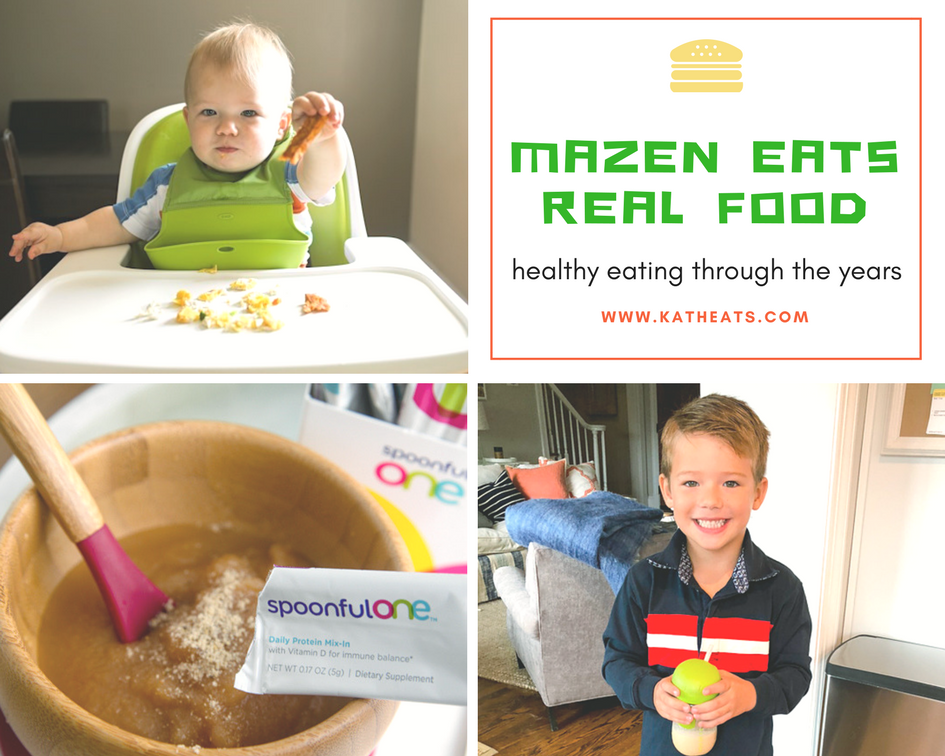
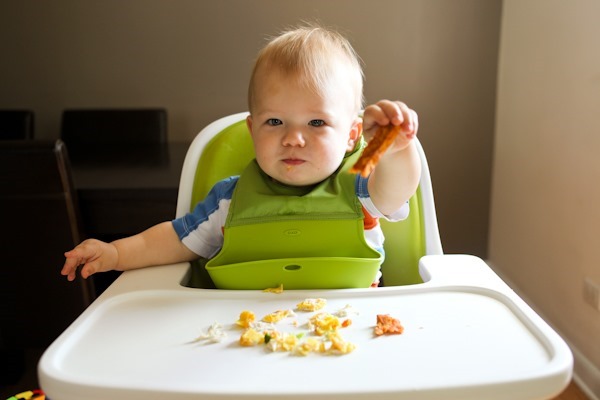
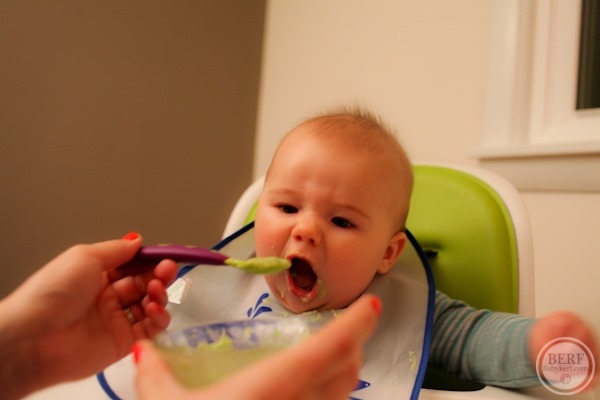
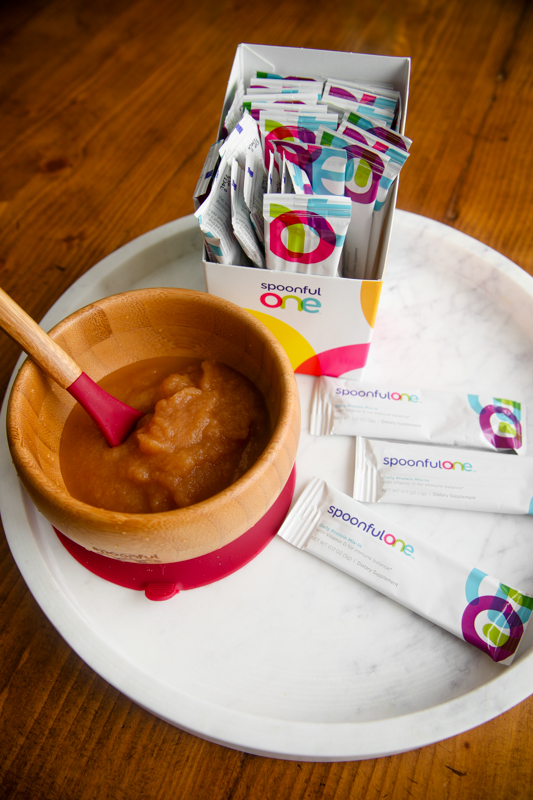
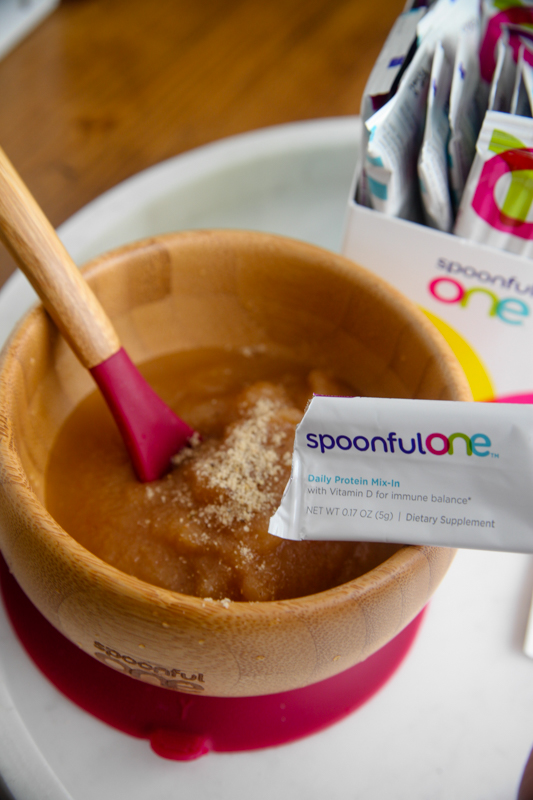
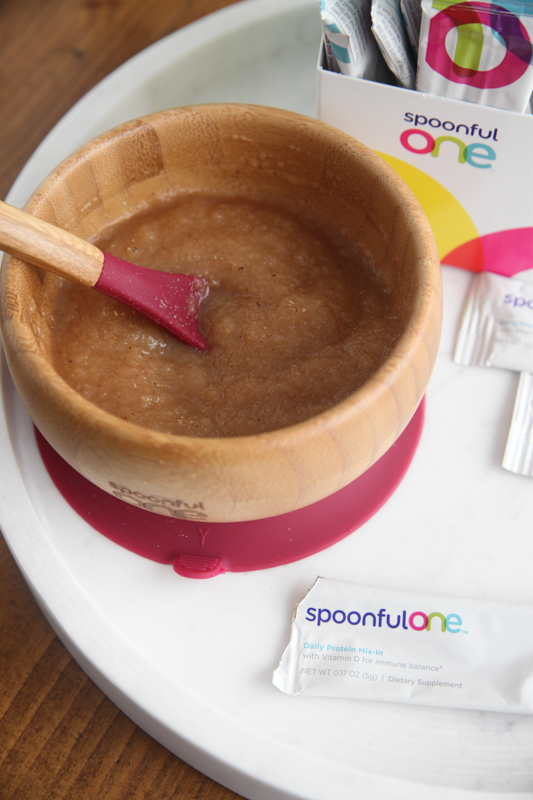
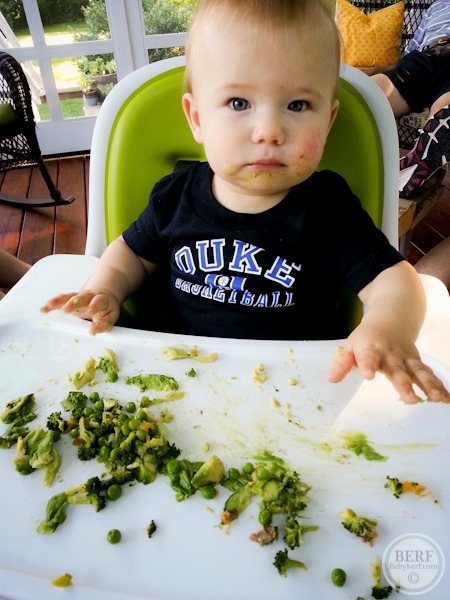
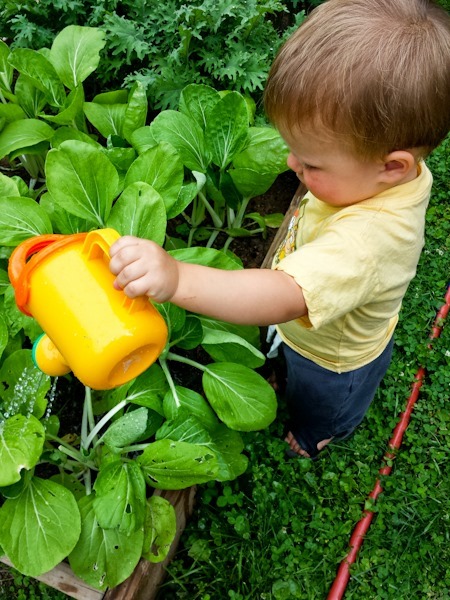
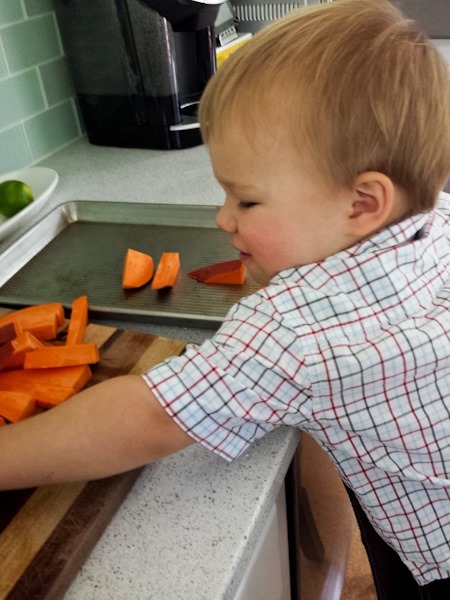

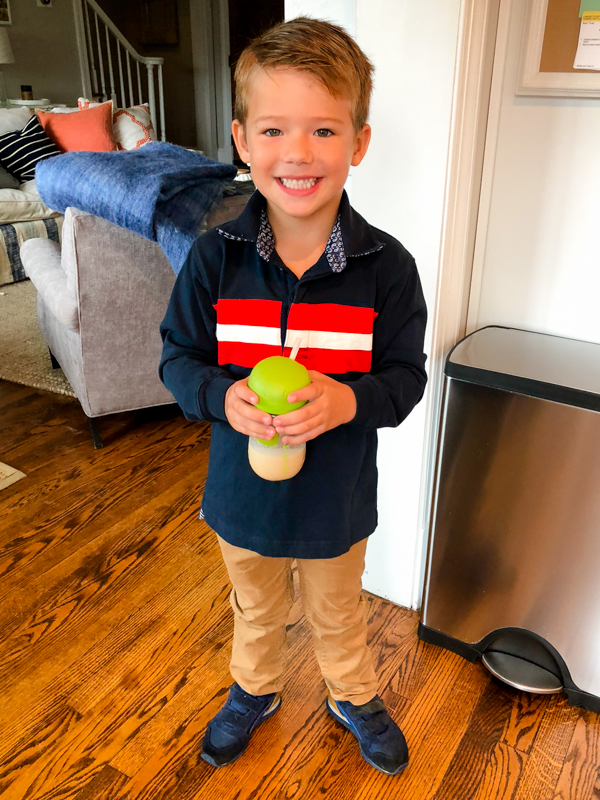
Charmaine Ng | Architecture & Lifestyle Blog says
What a fun post! It’s great of you to introduce healthy food to Mazen so early on!
Charmaine Ng | Architecture & Lifestyle Blog
http://charmainenyw.com
caitlinhtp says
Fun post and super interesting product!!!
Anne says
What a genius product! I introduced peanut butter and almond butter to my son (who is Mazen’s age) early on, but struggled finding a way to incorporate other tree nuts due to the choking factor. Now at age 5 he is very allergic to many of those other nuts (but NOT to peanuts or almonds), and I can’t help but wonder if I could have prevented his allergies by trying earlier. I would definitely try SpoonfulOne for any future children!
KathEats says
That is interesting, and I’m sorry you’re dealing with allergies! I wonder if there is any way to tell – perhaps in the future they will keep learning even more!
Michell says
Unfortunately, I was hesitant to give my daughter lots of variety due to only being able to incorporate them in at night she is not a well rounded eater what so ever. She eats zero fruit and the only veggies she eats is our garden canned green beans (no store bought) and frozen or fresh buttercup squash. She literally gages when you try to get her to eat any fruit. She eats gluten free pasta with melted sliced American cheese on it EVERY single night with her supper. She is a lover of meat which I am not so much. She is now 10 years old and I feel there is not a chance to get her to eat healthy at this point, although me and my husband continue to try. Any suggestions would be appreciated.
Krist says
Have you checked out the work of Ellen Satter? Additionally, if it’s really that bad, it might be time to seek professional help. My husband is a child psychologist who often works with kids and families with feeding/eating issues and I bet it would help! Good luck!
Tonya says
awww! Enjoyed the recap of Mazen through the years!
So pediatricians are now saying that introducing more foods earlier helps curb food allergies? That’s old school. The way all my family members were fed and the way my now college aged son was fed.. No special pouches. You gave the babies whatever was soft and smooshy and we were FINE. LOL Ok, maybe I remember saying something like “oh the doctor said just a little cereal in his milk right now”, only to be met with a side eye from the grandmas and aunties as they snuck the baby mashed potatoes and eggs because, after all, they grew YOU didn’t they? LOL
Bobbi says
Our pediatrician always said that family history does not necessarily play a factor in future childrens allergies. I also don’t understand this product- so if your child does have a significant allergy to something and this powder triggers it in some way, how will you know what the allergy is? I don’t know, maybe some would purchase this, but it seems like a waste of money. I normally am all for the products you recommend Kath, but this seems a bit over the top. To each their own, though.
Robin says
I completely agree with your concerns. As a RD and parent of children with food allergies, a product that is a blend of possible allergens would raise a red flag for me. I would never recommend introducing new foods as a blend (especially those that are some of the most common allergens).
Brigid says
I have three teenagers. My oldest was great eating veggies and fruits when they were pureed but as soon was they were chunky/real pieces he started with gagging on the food. To this day I would consider him a picky eater and you would probably be horrified by his diet. Although he doesn’t eat a lot of sweets, he doesn’t eat fruits or vegetables either. I hold out for the day when he is at a girl’s house that he really likes and he feels obliged to eat whatever is put in front of him, veggies included.
My second child is a better eater. She eats some fruit and veggies but with much coaxing. My youngest will try almost anything and really likes veggies.
I’m glad that doctors are pushing parents to have babies try new foods earlier. I’ve always believed in the theory of waiting longer to introduce peanuts and other common allergy foods can contribute for to a lack of tolerance. Obviously not true for everyone but I will say far more kids are allergic to foods than ever before and I personally think waiting contributes to this. I know it may be scary for some parents to introduce these foods but it sounds like this Spoonful One is a great option to use when doing so.
Anne Weber-Falk says
No allergies in this family. We have three children. All were raised to eat what we ate. The only thing we did by the books was the move to dairy products at the age of one if the kids were not weaned yet. I smashed up the foods well or cut into small bits for little fingers to pick up. It was what all my grandmas did and it really worked for us. Now they are all grown and they eat the way they want to eat. My 26 year old never really liked most meats unless it was chicken but now he eats them all. He is learning to like more vegetables as long as they are not mushy. He still eats way too many white foods and cheese. My 22 and 16 year olds are both adventurous eaters, not afraid to try new things. They have even gotten me to try new foods. All are healthy.
Paula Clark says
My babies are 47 and 44 now. I still have a copy of the diet that their doctor prescribed. We started cereal at a week old, just mixed in with formula. I didn’t breast feed. It just wasn’t pushed as it is now so I went with what my doctor suggested. We added new cereals weekly and then fruits and veggies, either home cooked and mashed or jars of baby food. Then we added eggs and meats. By the time they were 6 months old they were eating what we ate or as much of that as they could. Times change and we do things differently. My boys grew up to eat any and all food with no allergies. The youngest ate peanut butter and grape jelly sandwiches every day for most of this grade school years but he’s branched out to be a fabulous cook who eats anything, as has the other son. The oldest got migraines from food coloring so Cheese Balls and colored cupcake frosting were out for him. He grew out of that slowly. That wasn’t a bad thing. It did prevent him from eating all the cupcakes.
KathEats says
That’s so cool that you kept records of their baby diets!
Amanda @simplysatisfied.me says
That’s amazing to hear the differences 40 years ago!
Kelly says
As a fellow dietitian( working in a pediatrics hospital)I disagree with your statement of ‘food under one is just for fun.’ This is also not a statement that RDs support here in Canada and we are trying to educate the public regarding this. Is this something that has scientific evidence and encouraged in the US? If so I would love to see the information to provide up here!
KathEats says
I think this phrase applies to calories – that milk is still the primary nutrition force in the diet – and not that introducing food isn’t important in itself. I’m not practicing pediatrics though so maybe this has changed around too? Maybe a USA peds RD wants to chime in to compare?
Andrea says
Really? I’m a family doctor in Canada and myself and my colleagues still use the “under one just for fun” phrase with patients – meaning that breast milk or formula is the primary nutrition source and with the exception of fortifying iron stores, solids are for experimenting. Dietitians are the experts, so clearly i need to update my knowledge about this topic! Can you share any links to resources you’re using to educate patients?
Kate says
So my 3 boys eat the exact same thing every day. It’s this dried, pelletized food that is mostly bison and fish with a whole variety of fruits, veggies, and supplement-type things (probiotics, dried kelp, vitamins and minerals). Each fella gets about a cup a day and we just dump it in individual bowls and they wolf it down! We actually had to buy a special bowl for one of them because it was so good, he ate too fast and would choke!
You can buy it here:
https://www.solidgoldpet.com/product/wolf-king-with-bison/
Although, I’m not sure I’d recommend this method if your children are humans and not dogs 😉
KathEats says
Hahahaha!!!! If only humans were that easy!
Allison says
I have 3 kids – started them off all the same way . . . mashed avocado, veggies, ground nuts and beans . . . Kid #1 loved everything I made and to this day eats a variety of foods, Kid #2 refused to eat anything I made and even now as a teenager it’s a struggle to get her to eat a healthy variety of foods( or to eat at all), Kid #3 was a very healthy toddler eater but once she started kindergarten and going to sleep overs that all went out the window.
One thing I’ve learned whether it’s personalities or eating habits, nature tends to beat out nurture. You raise them all the same but they are their own person from day one!
KathEats says
Agree! You never know what you’re gonna get and I’m sure all kids have varying struggles
Amanda @simplysatisfied.me says
That’s very interesting to hear!!
Mer says
I have read a bunch of posts about this and agree with Bobbi. If your kid has a reaction, how do you proceed? I have been introducing my kids to everything we eat and we have no known allergy risks, but I would not use this product without more clear guidance. Even the website is lacking in how you navigate any adverse reactions. I guess I am confused about the benefits of this product over feeding a variety of Whole Foods?
Liz says
What?!?! I have never heard of this product but I’m totally going to ask my toddler’s allergist about it! My 2.5 year old has food allergies. We introduced peanut butter early and also almond milk (because we learned early on that she had a milk protein allergy) and I kind of assumed we were in the clear with nuts. But then I gave her a few bites of a larabar when she was about 1.5 and she broke out in hives all over her body. Turned out she has a cashew allergy! I can’t help wondering if we could have avoided it by introducing more types of nuts sooner, but that is hard to do! I have a new baby who is just starting solids and would love to use something like this if it is safe and effective. I guess my only concern would be if they do have an allergy to something in it how would you figure out which food triggered it? Anyway, something for me to look into. Thanks!
Liz says
As an update to this in case others are interested, I emailed my toddler’s allergist about this product and she gave me the go-ahead to try it with baby #2. Her advice was that if he has any type of reaction to it then I can bring him in for skin testing to figure out which allergen was problematic. She thinks the product is based on solid research and that the potential benefits outweigh the risks. Obviously, anyone thinking about using it should consult with their own child’s doctor, but just wanted to throw out there that a real live allergist not affiliated with the company who makes this told me she thinks it’s promising. 🙂
KathEats says
Thanks for checking and reporting back!
Liz says
Wow, what an interesting product idea. I’d love to hear more about the testing and use of it. Our second child, now 3, has anaphylactic allergies to peanuts and almonds, so we avoid all peanuts and treenuts. I nursed our 4 year old for a year, but our 3 year old for only about 5 months. We did BLW with both of them, and they were both very good eaters. Because my son had bad eczema, the ped recommended waiting to introduce peanuts and treenuts. Well, Granny was babysitting a day after his first birthday, gave him a bite of big sister’s pb&j, and we spent the rest of the day in the ER. It’s changed our lives in every way. We very rarely go out to eat, we have to be extremely careful with how we grocery shop (no may contain or manufactured in shared facilities because his allergies are so severe). Things like Halloween and parties at our older child’s preschool are extremely nerve wracking. I’m already so anxious about how school will go for him…and play dates and sleepovers and sports…the list goes on. The crazy thing is that I didn’t do a single thing differently (other than nurse him for less time) with either pregnancy or baby. The one thing that we think may have contributed to his food allergies is that he was very sick many times as an infant (strep, pneumonia, rsv, you name it and he had it) and he was on antibiotics many times before his first birthday. I believe that may have played a part in his allergies. My greatest hope is that there will be a cure or something of the in his lifetime, so that he will be able to go to a restaurant like a normal person and not worry that he could die from eating there. Anyway, I really wonder if things would be different for him now if we had used a product like the one you mention!
KathEats says
I’m so sorry you have to worry about contamination at every corner. That must be so difficult. I’d be willing to be the antibiotics did play a role.
Flo says
Liz, I’m sorry to hear about your child’s food allergies. You did nothing wrong. As a child, I was able to eat all kinds of food. When I turned 11, I was eating cherries and my mouth broke out in sores, my lips got big and I had trouble breathing. At age 11, I developed food allergies. I can’t eat any fresh fruit other than citrus, watermelon and bananas. I also have an almond allergy. At first the doctor thought my fruit allergy was from pesticides. My mom cleaned our fruit well before we ate them. I was allergy tested for fruits and almonds. It all came back positive. It’s just happens. I was able to eat all of those foods until I was 11. I’ve learned to adjust. I live in the US, but I found companies in Canada that makes all foods without any nuts. It’s not like here where it says may contain tree nuts. The facility is totally but free. They even make snack food we have here, but it’s all nut free. For the first time ever, I was able to eat granola. Google nut free Canada.
Erin says
Hi Liz,
Fellow allergy mom here. We have a kid who is ana to peanut. He is approaching his 8th birthday and I understand your fears! We do go out to eat and haven’t had any trouble, but I feel like I am ultra-stressed about things that are normal for most folks. We have our go-to places that we are comfortable taking him. My biggest issue has been school. I’ve fought tooth and nail for stricter guidelines and I haven’t finished yet. Where we live in Nebraska, allergy policy is up to the principal, which provides zero continuity throughout the district if we were to switch schools or even if we get a different principal. My best piece of advice to you is to just not be afraid to advocate. I have made few friends at his school, but as long as he is safe, that makes no difference to me. So far I have been successful in making some changes, and my ultimate goal is to remove food from the classrooms…but alas, Rome was not built in a day. 🙂
Just this morning I was telling someone that I feel like breastfeeding has a lot to do with my son’s allergies. I nursed him, but not exclusively and only until 7 1/2 months. He has severe eczema (we start phototherapy next week), horrid seasonal/enviro allergies, and has had 3 sets of tubes in his ears. My daughter breastfed exclusively for over 3 years and has had no health issues. None. Coincidence? I think not.
Amanda @simplysatisfied.me says
Thanks for this post. My 2 year old Brayden only likes the sweeter pouches and knows them by color examples like blue red and purple. If he sees a green pouch he says no way except for unsweetened applesauce. He generally likes carrots and green beans with grass fed butter and pink salt and he surprises me sometimes by eating cooked peppers. I would say he’s pretty picky though and what he likes changes from week to week sometimes day to day so it’s hard. We’ve put our foot down with dinner and he generally finds something at dinner he’ll eat and for now we’re ok with that.
Linda @ the Fitty says
Apparently you can get rid of allergies by introducing them into the diet little by little! In small dosages he body builds a tolerance.
Claire says
The recommendations for introducing solid foods (in general) remains at 6 months of age or when developmentally ready (whichever is later). There is less of a recommendation to withhold certain food families once food are introduced because of what you are talking about with food exposure. There has been a lot of research into ways to prevent food allergies, particularly in peanuts. In children who are at risk for allergies it has been found that daily exposure to a certain amount of peanut starting around age 4 months of age and persisting for, I believe, 3 years, leads to a MUCH lower risk of allergy. However, it is still recommended that this be done under supervision of a doctor due to these children being “at risk” of allergy. Because all of this is fairly new, a product like this makes me a little nervous for use without doctor supervision. It DOES seem like a good idea and I hope it is something that can be mainstreamed and helps reduce food allergies in our kids because the rates of food allergies seem to have sky rocketed!
Aly says
According to the American Academy of Pediatrics the recommendation remains around 6 months of age for solid food introduction. In fact introduction of solids prior to 4 months of age is associated with increased weight gain and adiposity in both infants and children. It has also been the expressed goal of multiple organizations- TJC, WHO, and AAP- to promote exclusive breastfeeding for the first 6 months of life as breast milk is the optimal source of growth and nutrition in infants according to research.
In my experience working as a professional at a pediatric hospital, very early introduction of solids can even be problematic for children such as those with underlying GI issues (constipation, reflux, delayed gastric emptying, etc.) and place them at increased risk for development of longer term feeding difficulties.
Sorry for the rant- as a feeding therapist and lactation consultant this topic is very close to my heart. Thanks for sharing the adorable pictures!
Sue says
21 years ago, the American Academy of Pediatrics advised delaying the introduction of peanuts to age 2. I followed the recommendation; neither of my children has that allergy. There is no history of peanut allergy in my family, however.
Two friends both deliberately introduced their infants to peanut butter before the age of 1; neither knew about the AAP stance on peanuts. Both those children developed life-threatening peanut allergies that persist to this day. One family had a history of actual nut allergy, one family had a member with an intolerance.
So according to CURRENT AAP recommendations, I did it “wrong” and my friends did it “right.” Yet they have the kids with peanut allergies. Sometimes, I think this allergy thing is a total crapshoot and there’s really not a whole lot you can do to prevent one.
Alicia Wise says
My daughter had really bad eczema from the moment she was born, and my father has an egg allergy, so as soon as she turned 5 months (she was just guzzling milk and super interested in food) we had the go-ahead to introduce allergens to her. Our ped gave her a blood test (the needle was awful I won’t lie) — and found that she was scoring 3’s (on a 5 point scale) for eggs and nuts, so once we started with a few low-allergen foods (avocado and sweet potato) we went to eggs and peanuts/tree nuts. She didn’t have any issues, thankfully. Good thing too, she loves eggs and nuts!! My husband likes to snack on mixed nuts and she loves to join him.
Our biggest issue with our stubborn 2.5 year old is getting her to try new things. It got better when she started going to bed a little later and could eat dinner with mom & dad – she was curious about what we were eating. I usually just give her whatever we’re having but make sure to have 1 thing on the plate that I know she’ll eat – a cheese stick, some fruit or plain yogurt — so I don’t need to worry about her going hungry – and sometimes she surprises us and tries something new and asks for seconds. We try not to talk about it (everything with her at 2 is about power) and just talk about our day. Last night she tried broccoli slaw (but wouldn’t touch a previous favorite of pulled pork and pineapple).
The other thing I do is talk about “favorite foods” – she always wants to be like mama, so I always talk about how I love kale and eat lots of salads for lunch in front of her….knowing that she watches every move has actually made me make (some) better choices. I still eat more goldfish crackers than I’d like to admit.